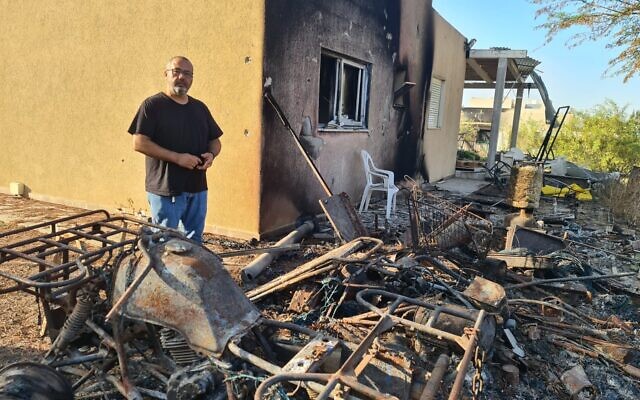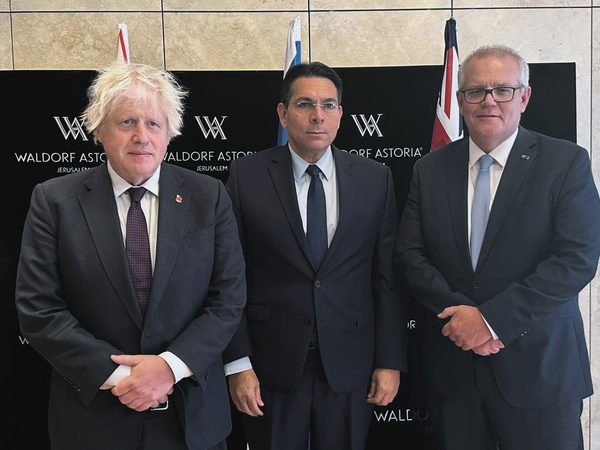1 month after Oct. 7 massacre, the ruins of Kibbutz Kfar Aza testify to its horrors
One month after their bucolic kibbutz turned into a site of carnage, Hanan Dann and Gili Okev returned for a brief visit.

(JTA) One month after their bucolic kibbutz turned into a site of carnage, Hanan Dann and Gili Okev returned for a brief visit — alongside two former world leaders, dozens of journalists and a handful of volunteers who were still engaged in the painstaking work of gathering the traces of their neighbors who were murdered.
The motley crew traipsing through Kibbutz Kfar Aza on Sunday had been brought together by the historic horror visited on the community of 750 on Oct. 7, when Hamas terrorists burst in. Between 52 and 60 people were murdered. Seventeen are believed to have been taken hostage in Gaza.
The residents returned to retrieve belongings. The world leaders — former British prime minister Boris Johnson and former Australian prime minister Scott Morris — and journalists had come to bear witness. And the volunteers were doing the same work they had been doing since days after the massacre, when they arrived to retrieve and prepare bodies for burial according to Jewish tradition.
They all carried on their work as the war that Israel launched in response to the attack carried on just kilometers away, its sounds audible and shadow palpable.
The bus carrying the press delegation stopped at the entrance to the kibbutz. David Baruch, who was accompanying the group on behalf of the Israel Defense Force’s spokesperson’s unit, instructed the 40 or so members of the press to walk the rest of the way, explaining that the IDF had received an alert for anti-tank missiles in the area and that the bus was a sitting target.
Baruch warned the journalists not to film any live reports. “The last time someone did that here ended up with four mortars fired from Gaza almost immediately,” he said.
When the group reached the “younger generation” zone, the area earmarked for young couples and families, the cruel capriciousness of the attack was laid bare. Around 40 houses, typical of kibbutz architecture in their modest appearance and size, had sustained varying degrees of destruction. Some were entirely blackened out, their walls pockmarked with holes made from grenade fragments. Others were left with gaping holes in their exterior walls from RPG impacts. All of them bore remnants of the lives that were once lived within their walls: a hammock covered with a thin film of dust, a handful of cards from a children’s game scattered among the rubble, a full mug of coffee on a kitchen table.
One house had the sentence “human remains on the couch” written in black paint on the outer wall. The adjacent wall featured yellow graffiti with the words “terrorist inside” and the date it was written, Oct. 11. One soldier at the site said Hamas terrorists were hiding in homes for days following the attack.
The couch inside the compact living room was stained with blood. Dann said his neighbors Sivan Elkabetz and Naor Hasidim were likely pulled out of their safe room and murdered on the couch.
“For the world this is maybe just another war in the Middle East. For Israelis this is a national tragedy,” Dann told the Jewish Telegraphic Agency. “But for me, this is a personal tragedy. These are people that are friends of mine.”
It was the second time Dann had toured that area of the kibbutz since the massacre. The first time he “lasted five minutes and couldn’t take it any more,” said Dann, a computer programmer who has been residing in the Tel Aviv suburb of Kfar Shmaryahu in the past weeks. His house, on the other side of the kibbutz, was spared and together with his wife, young children and parents, who had been visiting for the Simchat Torah holiday, he survived the hours-long ordeal in their safe room, reading terror-filled text messages from friends and neighbors, some the last they would ever send.
Dann recounted the harrowing story of the Almog-Goldstein family, in which it took a full week to determine, using DNA samples, that the father, Nadav, was killed alongside his eldest daughter, Yam, and that his wife, Chen, had been abducted to Gaza along with the couple’s younger three children.
“They couldn’t even count how many bodies there were after the murder,” Dann said.
“What would you rather hear? That your family has been all slaughtered and burnt to death? Or that they are being held captive by Hamas in Gaza? Which is the better news?” he asked. “This is the dilemma my friends are dealing with.”
The IDF’s tours of the kibbutz and other sites hard hit during the attack are meant to flood the world with firsthand information about what happened there to counteract the distortion and denial that have spread in the weeks since. As foreign news organizations rotate their staff in and out of the country, more journalists have been able to see what Israel wants them to share — but also locals are being asked to recite over and over the horrors they have seen.
“I saw heads, and I saw bodies,” said ZAKA volunteer Simcha Greineman after being asked by one reporter to verify IDF claims of Hamas beheadings. “I can’t say that I saw someone do [a beheading]. I collected heads without bodies, I collected bodies without heads, I collected children that were stabbed.”
He went on: “One child had his whole body burned but there was a knife stuck in his head from side to side.”
Images of decapitated corpses were shown to the group of journalists.
Greineman recounted a scene in which a family of five, including parents, two children and a grandmother, were found in the bedroom “standing in a circle, hugging each other, locked arms.” He and other volunteers from ZAKA, an organization that specializes in search and rescue for bodies, were tasked with detangling the family.
“We’re taking these last moments of life that they had, this circle, and we’re taking apart every body that was attached to each other, and putting them in the bag,” he said.
“It’s horrifying. People should not be mistaken about the savage attacks that occurred here,” said Johnson, who resigned as British prime minister last July.

“You can’t help but be overwhelmed by the sense of that where we’re standing was once, a month ago, a place of innocence and now has been desecrated beyond comprehension,” said Morrison.
Both Greineman and Dann spoke about the kibbutz families who had helped Palestinian workers from Gaza. Dann said he had a friend who had become close with one of the workers whose daughter was ill with a heart defect, and helped them get medication and medical care.
“We were glad that workers from Gaza were coming to Israel with work permits to have jobs to meet Israelis, to see that we’re not all ‘those devils,’” he said, gesturing with air quotes. “We all really believed that things are changing. That Hamas has maybe matured from being this terrorist group to being the grown up; taking responsibility for their people, worrying for their welfare. And that concept really blew up in our face.”
Members of one family who had hired a Palestinian employee were now in Gaza themselves as hostages, Dann said.
“I can’t tell you if one of those workers was a spy,” he said. “We can assume that probably yes because they had intelligence. They came here with maps. They knew exactly where everyone was.”
Okev, another resident who had returned to the kibbutz to gather some belongings, said he and his fellow kibbutz members were struck by an overwhelming feeling of “disappointment.”
“These people — not people, terrorists — they came to kill you just because you’re Jewish. There’s no other reason. They worked here, they lived here,” Okev told JTA. “We had lots of faith in them. But after seeing them over [in Gaza] celebrating on the streets, we lost faith.”
Okev spent seven hours trapped with his wife in their safe room with the terrorists just on the other side of the wall on the couple’s porch. According to Okev, they used the porch as a kind of headquarters to issue commands. The area was strewn with soot and charred farming tools, the aftermath of a battle between the terrorists and Israeli forces that would later unfold.
During their time inside the safe room, the couple, whose adult sons were not on the kibbutz when the infiltration occurred, sat quietly, prayed occasionally, and set up a blockade by the door.
“It wasn’t a question of whether they would enter or not, it was a question of when,” he said.
But they didn’t. Okev has no explanation as to why his life was spared when 12 of his close friends were murdered.
“Divine providence, what can I tell you,” he said. “There’s someone watching over us. He didn’t watch over the others, apparently. Or they were too good so He took them.”
Dann is unsure about whether he will ever return to the kibbutz.
“Even though my individual house is intact, this place is so full of blood. It’s a question that is still too big for me and still too big for everybody,” he said.
Okev, meanwhile, has a different take.
“We will come back here and we’ll build this place and it will flourish and grow. It won’t stay like this,” he said. “We won’t let them move us.”

comments